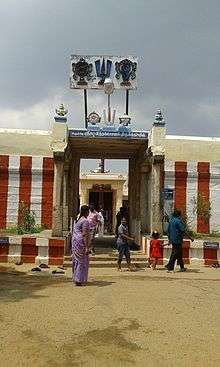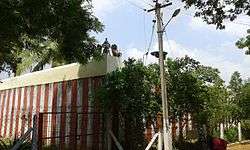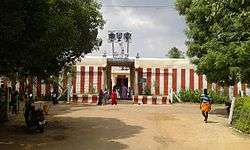Aravindalochanar temple
Aravindalochanar Perumal Temple in Tholavillimangalam, a village in Thoothukudi district in the South Indian state of Tamil Nadu, is dedicated to the Hindu god Vishnu. It is located 22 km from Tirunelveli. Constructed in the Dravidian style of architecture, the temple is glorified in the Divya Prabandha, the early medieval Tamil canon of the Azhwar saints from the 6th–9th centuries AD. It is one of the 108 Divyadesam dedicated to Vishnu, who is worshipped as Aravindalochanar and his consort Lakshmi as Karunthadankanni.[1] The temple is also classified as a Navatirupathi, the nine temples revered by Nammazhwar located in the banks of Tamiraparani river. Along with the Devapiran temple located 100 yards away, the temple is referred as Irattai Tirupathy (meaning twin Tirupathis). This temple is a Rahu Sthalam.
| Aravindalochanar Temple | |
|---|---|
 | |
| Religion | |
| Affiliation | Hinduism |
| District | Thoothukudi |
| Deity | Aravindalochanar(Vishnu) Karunthadankanni(Lakshmi) |
| Location | |
| Location | Tholaivillimanagalm |
| State | Tamil Nadu |
| Country | India |
 Location in Tamil Nadu | |
| Geographic coordinates | 8°36′43″N 77°58′19″E |
| Architecture | |
| Type | Dravidian architecture |
| Website | |
| navathirupathitemples | |
A granite wall surrounds the temple, enclosing the main shrine and pillared halls. Unlike other South Indian temples, the temple does not have a rajagopuram, the temple's gateway tower and has a flat gateway. The Vijayanagar and Nayak kings commissioned pillared halls and major shrines of the temple during the 16th century.
The temple follows Thenkalai tradition of worship. Four daily rituals and three yearly festivals are held at the temple, of which the ten-day annual Vaikunta Ekadasi during the Tamil month of Margazhi (December - January) and the Nammazhwar birth celebrations with Garudasevai with all nine temple of Navatirupathi, being the most prominent. In modern times, the temple is maintained and administered by the Hindu Religious and Endowment Board of the Government of Tamil Nadu.
Architecture

The exact history of the temple is not known, but it is understood from the neighbouring inscriptions, the temple has been a part of a series of temples built by Pandyas and expanded by Madurai Nayaks. The temple occupies an area of 1 acre (0.40 ha) and is surrounded by a granite wall. The rajagopuram, the temple's gateway tower, is a flat structure, unlike other South Indian temples, which have a conical elevated structure. A granite wall surrounds the temple, enclosing all its shrines and halls. The sanctum houses the image of Aravindalocha facing east. The image is made of Saligrama stone. The hall preceding the sanctum, the Artha Mandapam houses the festival image of Aravindalocahanar with the images of Sridevi and Bhudevi on either of his sides. The Mahamandapa has shrines for Senai Mudaliyar, Garuda, Venugopala, Manavalamamunigal and Azhwars.[2][3]
Religious significance

Brahmanda Purana one of the eighteen sacred texts of Hinduism and written by Veda Vyasa contains a chapter called Navathirupathi Mahatmeeyam that describes all the nine temples of Navatirupathi.[2] Aravindalochanar temple is revered in Nalayira Divya Prabandham, the 7th–9th century Vaishnava canon, by Nammazhwar. The temple is classified as a Divyadesam, one of the 108 Vishnu temples that are mentioned in the book. The temple is also classified as a Navatirupathi, the nine temples revered by Nammazhwar located in the banks of Tamiraparani river.[2][3] Nammazhwar makes a reference about the temple in his works in Thirvaimozhi. During the 18th and 19th centuries, the temple finds mention in several works like 108 Tirupathi Anthathi by Divya Kavi Pillai Perumal Aiyangar.[2] The temple also forms a series of Navagraha temples where each of the nine planetary deities is associated with one of the temples of Navatirupathi. The temple is associated with Rahu, a snake planet. Along with the Devapiran temple located 100 yards away, the temple is referred as Irattai Tirupathy (meaning twin Tirupathis).[4]
Festival
The Garuda Sevai utsavam(festival) in the month of Vaikasi(May-Jun) witnesses nine Garudasevai, a large event in which festive images from the Nava Tirupathi shrines in the area are brought on Garuda vahana(sacred vehicle) to Alwarthirunagari Temple. An idol of Nammalvar is also brought on an Anna Vahanam (palanquin) and his paasurams (verses) dedicated to each of these 9 temples are recited. The utsavar(festival deity) of Nammalvar is taken in a palanquin to each of the nine temples, through the paddy fields in the area. The paasurams(poems) dedicated to each of the nine Divyadesams are chanted in the respective shrines. This is the most important of the festivals in this area, and it draws thousands of visitors.
The temple follows the traditions of the Thenkalai sect of Vaishnavite tradition and follows Pancharathra aagama. The temple priests perform the pooja (rituals) during festivals and on a daily basis. There are weekly, monthly and fortnightly rituals and festivals performed in the temple.[3]
References
- M. S., Ramesh (1993). 108 Vaishnavite Divya Desams: Divya desams in Pandya Nadu. Tirumalai-Tirupati Devasthanam..
- M., Rajagopalan (1993). 15 Vaishnava Temples of Tamil Nadu. Chennai, India: Govindaswamy Printers. pp. 155–159.
- "Sri Aravindalochanar temple". Dinamalar. 2014. Retrieved 31 May 2014.
- "Amazing posture at Srivaikuntam". The Hindu. 15 November 2001. Retrieved 25 October 2015.